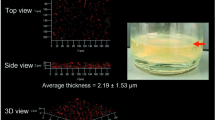Abstract
Vibrio tapetis CECT4600 is a pathogenic Gram-negative bacterium causing the brown ring disease in the Manila clam Ruditapes philippinarum. This vibriosis is induced by bacterial attachment on the periostracal lamina, yielding a decalcification of the bivalve shell. As in many bacterial species, pathogenesis is likely related to biofilm formation. The proteinaceous exoproducts of the marine bacterium Pseudoalteromonas sp. 3J6 inhibit the formation of biofilm by most of the tested marine bacteria without affecting their planktonic growth. In the present work, we examined the sensitivity of V. tapetis to Pseudoalteromonas sp. 3J6 and its exoproducts. In V. tapetis CECT4600-GFP–Pseudoalteromonas sp. 3J6 co-cultures, the latter outcompeted V. tapetis whatever the growth mode (planktonic or biofilm), which could result from a slower growth of V. tapetis. Biofilms containing only V. tapetis were grown in vitro on a glass substratum under dynamic conditions. When the glass was coated with a culture supernatant of Pseudoalteromonas sp. 3J6 (SN3J6) prior to inoculating V. tapetis CECT4600-GFP, the bacterial attachment was about fivefold lower than in control experiment without SN3J6 and the biofilm formation was delayed by about 24 h: A full biofilm was obtained at 48 versus 24 h for the control. Moreover, a preformed V. tapetis biofilm (grown on SN3J6-free glass substratum) could be disrupted by incubating it with SN3J6. This data suggest that Pseudoalteromonas sp. 3J6 is a good candidate to set up an anti-V. tapetis strategy usable in aquaculture to grow V. tapetis-free Manila clam spats.



Similar content being viewed by others
References
Paillard C, Maes P (1990) Étiologie de la maladie de l’anneau brun chez Tapes philippinarum (Mollusque, bivalve). C R Acad Sci III-Vie 310:15–20
Borrego JJ, Castro D, Luque A, Paillard C, Maes P, Garcia MT, Ventosa A (1996) Vibrio tapetis sp. nov., the causative agent of the brown ring disease affecting cultured clams. Int J Syst Bacteriol 46:480–484
Paillard C, Maes P (1995) The brown ring disease in the Manila clam, Ruditapes philippinarum. I. Ultrastructural alterations of the periostracal lamina. J Invertebr Pathol 65:91–100
Borrego JJ, Luque A, Castro D, Santamaria JA, Martinez-Manzanares E (1996) Virulence factors of Vibrio P1, the causative agent of brown ring disease in the Manila clam, Ruditapes philippinarum. Aquat Living Resour 9:125–136
Lopez-Cortes L, Luque A, Martinez-Manzanares E, Castro D, Borrego JJ (1999) Adhesion of Vibrio tapetis to clam cells. J Shellfish Res 18:91–97
Costerton JW, Stewart PS, Greenberg EP (1999) Bacterial biofilms: a common cause of persistent infections. Science 284:1318–1322
Parsek MR, Singh PK (2003) Bacterial biofilms: an emerging link to disease pathogenesis. Annu Rev Microbiol 57:677–701
Donlan RM (2002) Biofilms: microbial life on surfaces. Emerg Infect Dis 8:881–890
Huq A, Whitehouse CA, Grim CJ, Alam M, Colwell RR (2008) Biofilms in water, its role and impact in human disease transmission. Curr Opin Biotechnol 19:244–247
Donlan RM (2009) Preventing biofilms of clinically relevant organisms using bacteriophage. Trends Microbiol 17:66–72
Estrela AB, Heck MG, Abraham WR (2009) Novel approches to control biofilm infections. Curr Med Chem 16:1512–1530
Holmström C, Kjelleberg S (1999) Marine Pseudoalteromonas species are associated with higher organisms and produce biologically active extracellular agents. FEMS Microbiol Ecol 30:285–293
Bowman JP (2007) Bioactive compound synthetic capacity and ecological significance of marine bacterial genus Pseudoalteromonas. Mar Drugs 5:220–241
Hayashida-Soiza G, Uchida A, Mori N, Kuwahara Y, Ishida Y (2008) Purification and characterization of antibacterial substances produced by a marine bacterium Pseudoalteromonas haloplanktis strain. J Appl Microbiol 105:1672–1677
Klein GL, Soum-Soutéra E, Guede Z, Bazire A, Compère C, Dufour A (2011) The anti-biofilm activity secreted by a marine Pseudoalteromonas strain. Biofouling 27:931–940
Grasland B, Briandet R, Quemener E, Meylheuc T, Vallée-Réhel K, Haras D (2003) Bacterial biofilm in seawater: cell surface properties of early-attached marine bacteria. Biofouling 19:307–313
Dheilly A, Soum-Soutéra E, Klein GL, Bazire A, Compère C, Haras D, Dufour A (2010) Antibiofilm activity of the marine bacterium Pseudoalteromonas sp. strain 3J6. Appl Environ Microbiol 76:3452–3461
Klein G (2011) Nouvelles molécules naturelles inhibitrices du développement de biofilms de bactéries marines. Ph.D. thesis, Université de Bretagne Occidentale, France
Travers MA, Barbou A, Le Goïc N, Huchette S, Paillard C, Koken M (2008) Construction of a stable GFP-tagged Vibrio harveyi strain for bacterial dynamics analysis of abalone infection. FEMS Microbiol Lett 289:34–40
Mårdén P, Tunlid A, Malmcrona-Friberg K, Odham G, Kjelleberg S (1985) Physiological and morphological changes during short term starvation of marine bacterial isolates. Arch Microbiol 142:326–332
Zobell CE (1941) Studies on marine bacteria. I. The cultural requirements of heterotrophic aerobes. J Mar Res 4:41–75
Pamp SJ, Sternberg C, Tolker-Nielsen T (2009) Insight into the microbial multicellular lifestyle via flow-cell technology and confocal microscopy. Cytometry Part A 75:90–103
Tolker-Nielsen T, Sternberg C (2011) Growing and analyzing biofilms in flow chambers. Curr Protoc Microbiol 1B:2.1–2.17
Heydorn A, Nielsen AT, Hentzer M, Sternberg C, Givskov M, Ersbøll BK, Molin S (2000) Quantification of biofilm structures by the novel computer programme COMSTAT. Microbiology 146:2395–2407
Acknowledgments
S.R. is the recipient of a doctoral fellowship from Région Bretagne and was supported by the Axis 1 of GIS Europôle Mer. This work was performed in the framework of LabexMER “A Changing Ocean” ANR-10-LABX-19-01, which is a cluster of Excellence funded by the French “Investissements d’Avenir” program, supported by French Ministry of Research and Education.
Conflict of interest
The authors declare that they have no conflict of interest.
Author information
Authors and Affiliations
Corresponding author
Rights and permissions
About this article
Cite this article
Rodrigues, S., Paillard, C., Dufour, A. et al. Antibiofilm Activity of the Marine Bacterium Pseudoalteromonas sp. 3J6 Against Vibrio tapetis, the Causative Agent of Brown Ring Disease. Probiotics & Antimicro. Prot. 7, 45–51 (2015). https://doi.org/10.1007/s12602-014-9173-3
Published:
Issue Date:
DOI: https://doi.org/10.1007/s12602-014-9173-3




